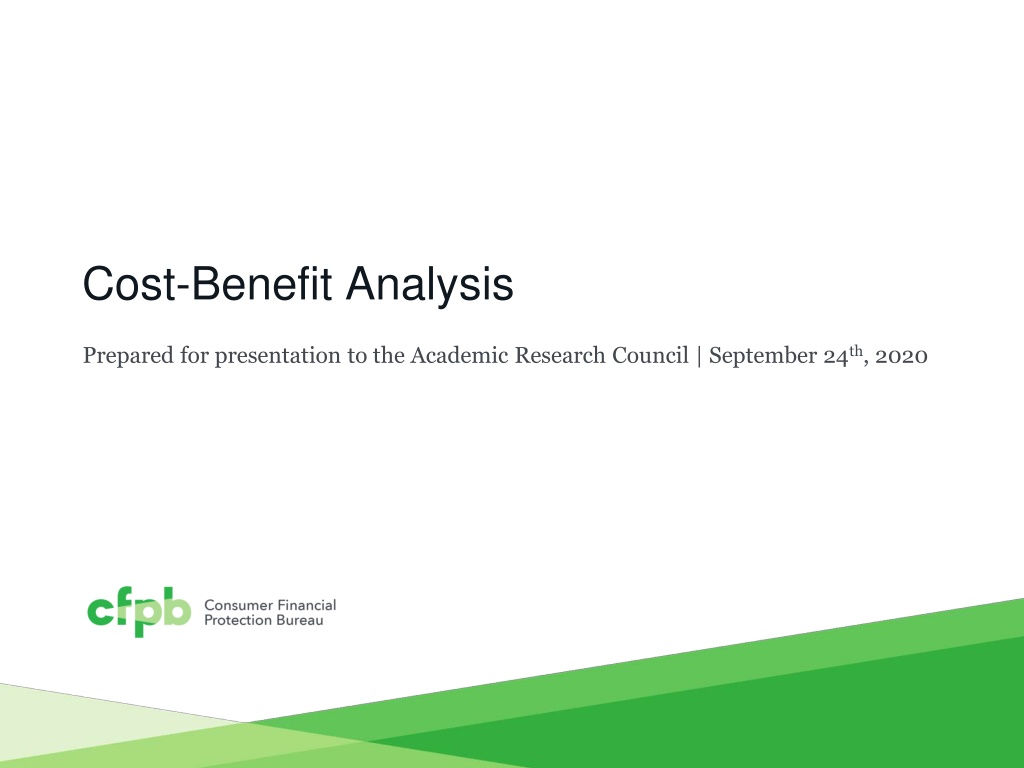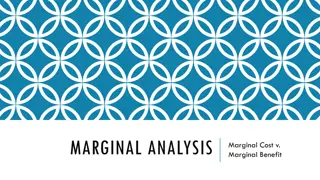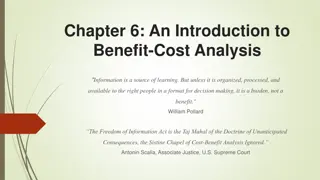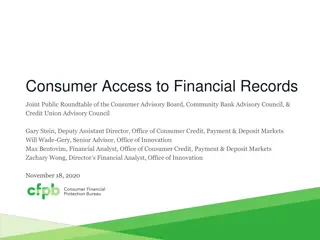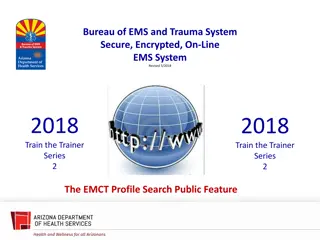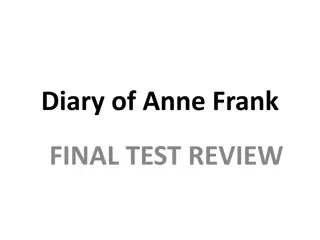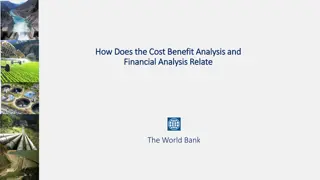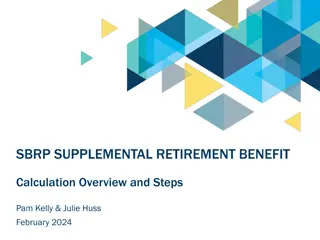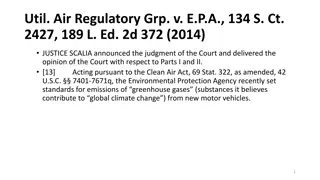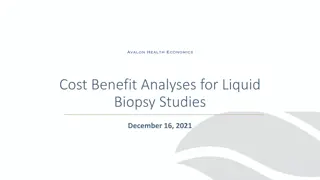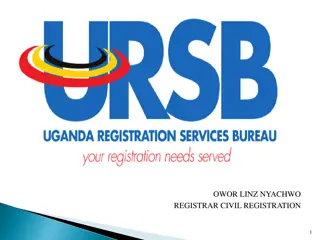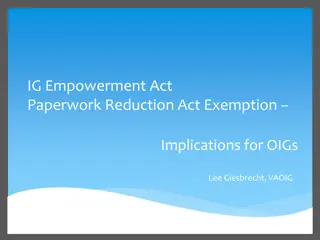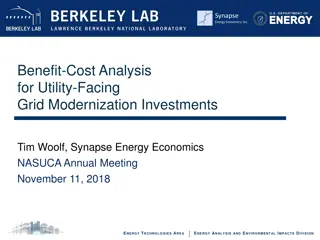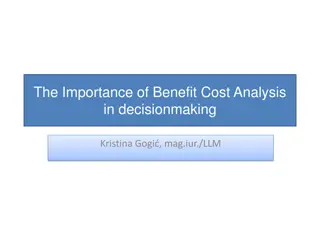Bureau Practices and Requirements in Cost-Benefit Analysis Under Dodd-Frank Act
Bureau practices and requirements for cost-benefit analysis under the Dodd-Frank Act are essential in evaluating the potential benefits, costs, and impacts of significant rules or orders in consumer financial law. These practices include staffing teams with experts, making offices accountable for analyses, and publishing analyses with proposed rules. The Dodd-Frank Act mandates assessments of rules and orders, ensuring effectiveness and alignment with specific goals. Public comments are invited for modification recommendations before report publication.
Download Presentation

Please find below an Image/Link to download the presentation.
The content on the website is provided AS IS for your information and personal use only. It may not be sold, licensed, or shared on other websites without obtaining consent from the author. Download presentation by click this link. If you encounter any issues during the download, it is possible that the publisher has removed the file from their server.
E N D
Presentation Transcript
Cost-Benefit Analysis Prepared for presentation to the Academic Research Council | September 24th, 2020
Disclaimer This presentation is being made by Consumer Financial Protection Bureau representatives on behalf of the Bureau. It does not constitute legal interpretation, guidance, or advice of the Consumer Financial Protection Bureau. This document was used in support of a live discussion. As such, it does not necessarily express the entirety of that discussion nor the relative emphasis of topics therein. 2
Dodd-Frank Act In substantive rulemakings, Section 1022(b) of the Dodd-Frank Act requires the CFPB to consider: The potential benefits and costs to consumers and covered persons; The potential reduction of access by consumers to consumer financial products or services; The impact on consumers in rural areas; The impact on insured depository institutions or credit unions with total assets of $10 billion or less. 3
Dodd-Frank Act (continued) Section 1022(d) of the Dodd-Frank Act requires the CFPB to conduct an assessment of each significant rule or order adopted by the Bureau under Federal consumer financial law. The Bureau must publish a report of the assessment not later than five years after the effective date of such rule or order. The assessment must address, among other relevant factors, the rule or order's effectiveness in meeting the purposes and objectives of title X of the Dodd-Frank Act and the specific goals stated by the Bureau. The assessment must reflect available evidence and any data that the Bureau reasonably may collect. Before publishing a report of its assessment, the Bureau must invite public comment on recommendations for modifying, expanding, or eliminating the rule or order. 4
Bureau Practice The Bureau established practices in early 2012 to meet the Section 1022(b) cost-benefit requirement in Dodd-Frank. These practices include: Staffing teams in substantive rulemakings with economists and market experts as well as attorneys and integrating the consideration of benefits, costs and impacts into the rulemaking process; Making the Office of Research accountable for the analyses required by Section 1022(b); 5
Bureau Practice (continued) Publishing with proposed and final substantive rules a Section 1022(b) analysis that reviews significant regulatory requirements for the expected benefits, costs and impacts specified in that section and which meets general standards for cost-benefit analysis, such as: Using an explicit baseline consistently throughout the analysis, Considering the effects of significant alternatives to the rule, Quantifying and monetizing the costs and benefits where appropriate and reasonably feasible to do so (possibly using estimates, ranges or outer boundaries), and explaining why potentially significant benefits or costs cannot be quantified or monetized. 6
Cost-Benefit Analysis of Financial Regulation Like the CFPB, neither the financial regulators (Board of Governors, FDIC, OCC, CFTC, SEC) nor the FTC are subject to Executive Order 12866 on cost-benefit analysis and related OMB requirements. Unlike the CFPB, these agencies do not have a general statutory requirement to consider the expected costs and benefits that applies to most of the rules that they issue. The SEC and CFTC are required to consider a particular set of effects in certain rulemakings. The FTC generally does not issue rules pursuant to special rulemaking procedures that require broader consideration of benefits and cost. One result is there are fewer examples of cost-benefit analysis of financial regulation and consumer protection regulation than there are of other types of regulation. 7
Cost-Benefit Analysis of Financial Regulation There is also debate over whether financial regulations especially regulations to promote stability in financial markets, but also regulations to protect consumers from harms in financial markets present unique challenges to rigorous and quantified cost-benefit analysis. For example: Outcomes are heavily dependent on human behavioral responses The financial system changes more quickly than other industries The effects of financial regulation often consist largely of wealth transfers between groups. Source: Perkins and Carey, Cost-Benefit Analysis and Financial Regulator Rulemaking, Congressional Research Service (2017). 8
Questions 1. Consider the brief summary of Bureau practices in cost-benefit analysis. Which elements would you like to discuss further? What appears to be missing? 9
Questions 2. Many consumer financial products or services involve an initial transaction, such as the origination of credit, followed by a potentially long period of repayment. The supply of consumer credit therefore depends not only on the up-front fees and charges, but also on the interest rate and the risk of consumer delinquency and default. Consumer financial protection regulations directly affect all of these elements of supply, including the ability of providers to manage the risk of default and the extent of losses in the event of default. How might the Bureau improve its ability to model and measure these effects? For example, what types of outreach and collaboration would be most productive? What types of data collection would be most useful? 10
Questions 3. Continuing the above, the demand for consumer credit depends on how consumers understand the costs and features of consumer credit and the risk of delinquency and default. How might the Bureau improve its ability to model and measure these effects? For example, what types of outreach and collaboration would be most productive? What types of data collection would be most useful? 11
Questions 4. Are you aware of simple and practical metrics of consumer benefits or harms that might inform Bureau practice in cost-benefit analysis in the near term? How important for decisionmakers is understanding the distribution of benefits and costs over different categories of (a) consumer financial service providers and (b) consumers? 12
Questions 5. As noted above, Section 1022(d) of the Dodd-Frank Act requires the Bureau to conduct an assessment of each significant rule or order adopted by the Bureau under Federal consumer financial law. The assessment must address, among other relevant factors, the rule or order's effectiveness in meeting the purposes and objectives of title X of the Dodd-Frank Act and the specific goals stated by the Bureau. Do you see the differences between measures of the effectiveness of a previously adopted rule and measures of the costs and benefits of the rule? Based on your research or experience, should the Bureau try to measure the cumulative or annual costs and benefits of rules subject to assessments, or should the Bureau focus on measuring effectiveness? 13
